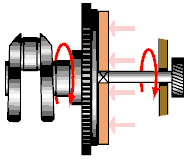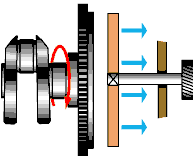The transmission is used to transmit torque from the engine to the drive wheels and to change the magnitude of the torque and its direction. Let's talk about car clutch device - what it consists of and how it works.
car clutch designed to transmit torque from the flywheel of the crankshaft of the engine to the input shaft of the gearbox. The clutch allows the driver to briefly interrupt the transmission of torque, as if to separate the engine from the transmission, and then smoothly connect them.
The clutch consists of: drive and clutch mechanism.
Clutch Release Drive
Further study of the car is impossible without understanding the term - drive unit. Let's try to deal with it.When it is necessary to transfer force in a car, for example, from the driver to a certain mechanism, then problems can arise. In order for the car to work properly, and the driver to be in his place, there is mechanism drive.
Imagine a situation where you need to constantly close and open something, but you yourself cannot move. To transfer force at a distance by "opening" and "closing" the door, you will have to use a stick or remote control. Let it be a stick tied with ropes at one end to your hand and the other to the door handle. In this case, a stick with ropes will be a "drive" that will transmit force at a distance.
In a car, each mechanism has its own drive, through which it is put into action. The drive may consist of a large number of individual components and parts, it may be mechanical, hydraulic. 
Diagram of the hydraulic drive for disengaging the clutch and the clutch mechanism
1 - crankshaft; 2 - flywheel; 3 - driven disk; 4 - pressure plate; 5 - clutch cover; 6 - pressure springs; 7 - squeezing levers; 8 - pressure bearing; 9 - clutch release fork; 10 - working cylinder; 11 - pipeline; 12 - main cylinder; 13 - clutch pedal; 14 - clutch housing; 15 - gear of the input shaft; 16 - gearbox housing; 17 - the input shaft of the gearbox.
Clutch release actuator (hydraulic type) comprises:
When you press the clutch pedal, the force of the driver's foot, through the rod and piston, is transmitted to a fluid that transfers pressure from the master cylinder piston to the slave piston. Further, the rod of the working cylinder moves the clutch release fork and the thrust bearing, which transmits force to clutch mechanism. When the driver releases the pedal, then under the influence of the return springs, all parts of the drive will take their original positions.
The hydraulic clutch uses brake fluid. Before pouring it into the drive reservoir, it is worth reading what is written on the label. Is it allowed to mix it with a liquid that is already filled in the hydraulic clutch of a car? As a rule, the answer is yes, but there are liquids that cannot be mixed.
Front-wheel drive vehicles use a mechanical drive, where the clutch pedal is connected to the release fork with a metal cable.
clutch mechanism
clutch mechanism is a device in which torque is transmitted due to the work of friction forces. The clutch mechanism allows you to briefly separate the engine and gearbox, and then smoothly connect them. The elements of the mechanism are enclosed in the clutch housing, which is attached to the engine crankcase.The clutch mechanism consists of:
The driven disc is constantly pressed against the flywheel by a pressure plate under the influence of strong springs. Due to the huge frictional forces between the flywheel, driven and pressure plates, all this rotates together when the engine is running. But only when the driver does not touch the clutch pedal, regardless of whether the car is moving or standing still.
To start the movement of the machine, it is necessary to press the driven disk connected to the drive wheels to the rotating flywheel, that is, to engage the clutch. And this is a difficult task, since the angular speed of rotation of the flywheel is 20 - 25 revolutions per second, and the speed of rotation of the drive wheels is zero.

How to do it? To do this, you must always release the clutch pedal correctly, only in three stages.
At the first stage work on engaging the clutch - release the pedal, i.e. we give the opportunity to the springs of the pressure plate to bring the driven disk to the flywheel until they lightly touch. Due to the forces of friction, the disk, slipping for some time relative to the flywheel, will also begin to rotate, and the car will slowly crawl.At the second stage- we keep the driven disk from any movement, i.e. for two to three seconds, hold the clutch pedal in the middle position so that the speed of rotation of the flywheel and disk is equalized. At the same time, the machine increases the speed of movement.
At the third stage- the flywheel together with the pressure and driven disks already rotate together without slipping and at the same speed, 100% transferring torque to the gearbox and then to the driving wheels of the car. This corresponds to the state of the clutch mechanism - on, the car is moving. Now it remains only to completely release the clutch pedal and remove your foot from it.
If, at the beginning of the movement, the clutch pedal is abruptly thrown, the car will “jump” forward, and the engine will stall.
To disengage the clutch the driver presses the pedal, while the pressure plate moves away from the flywheel and releases the driven disc, interrupting the transmission of torque from the engine to the gearbox. Press the clutch pedal should be fast enough, but not abrupt, calm movement until the end of the pedal stroke.

The actions of the driver to disengage and engage the clutch during the trip are repeated many times. However, mastering the operation of the clutch pedal in three stages, later it will become a habit that will ensure the smooth running of the car and the comfort of passengers.







